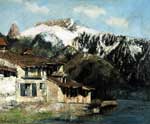VAM galleries including this work:
The Speed Art Museum | Art Through Time || VAM Home
Gustave Courbet (French, 1819-1877)
THE ARTIST’S HOUSE, LA DENT DE JAMAN, c. 1874
Oil on canvas; 19-3/4" X 24"
Bequest of Mrs. Blakemore Wheeler, 64.31.5
The Speed Art Museum
This painting is a landscape, a work of art depicting an outdoor scene. While a landscape painting can include objects such as buildings and people, the natural forms such as mountains, sky, and trees are the main focus. In this painting, Gustave Courbet presents a straightforward view of his own house on Lake Geneva in Switzerland. (La Dent de Jaman is the tooth-shaped mountain in the upper left of the painting.) We see the house, the mountain, and the lake in bright daylight and harsh shadows. There is no gloomy mist or glowing twilight to inject emotional meaning. The mountain and the house appear solid and heavy, as they would in real life.
Courbet created portions of this landscape by applying the oil paint to the canvas with a palette knife, a painter’s tool much like a very small spatula or trowel. Unable to create softened areas of color or fine details as he would with a brush, the artist worked in broad areas of paint applied thickly to the surface of the canvas. The result is a landscape that has very few details and a richly textured surface.
About the Artist
Gustave Courbet was a leader in the 19th-century movement in painting that we know as Realism. Realist artists focused attention on ordinary people, such as peasants and laborers, who had not been pictured in art up to that time. Realists also depicted real scenes from contemporary life, from city street scenes to country funerals. They tried to show the beauty in the commonplace, refusing to idealize or gloss over reality as Neoclassical and Romantic artists had.
Courbet was born to a prosperous farming family in Ornans, France. His father sent him to Paris to study law in 1841, but Courbet soon decided to study painting, learning by copying the pictures by master artists at the Louvre. His choice of ordinary subject matter and realistic portrayals were at odds with the established aesthetics, and when his work The Artist’s Studio was refused for an important exhibition, he displayed his work himself near the exhibition hall. Courbet believed that painters should paint only their own time and that “painting is an essentially concrete art, and can consist only of representation of real and existing things.”
The work of Courbet and other Realists helped pave the way for the painters of the Impressionist movement. By focusing on the world around them as possible subjects for paintings, the Realists were role models who abandoned traditional themes and approaches to painting. The younger Impressionist artists used the example of the Realists as a point of departure for working out of doors, painting landscapes and scenes that were done on site and away from a studio setting.
Classroom Ideas
Discussion: Discuss foreground, middle ground, and background in landscape. What is in each section in this landscape? (Foreground—house, middle ground—mountains, background—clouds).
How could this landscape have been idealized? What do you think about Courbet’s belief that artists should paint only real and existing things? What makes this painting an example of Realism? Is it balanced? Does it use symmetry? What colors do you notice first in the painting? What stands out? Can you tell what country the house is located in?
Discuss some of the textures in the painting. Can you tell what the house is made of? Is the mountain rough or smooth? Do you see other textures?
Activities: List everyday scenes of life. (Examples: brushing your teeth, riding the bus, reading.) Choose a scene and paint or draw it in a realistic style. Draw or paint your house. Choose a realistic or other style and explain why you chose that style.
Go outside and capture a scene. Look at the landscape and think about the foreground, middle ground, and background. (You could use an empty slide case as a viewfinder or window to demonstrate a picture plane.) Now draw or paint a picture that shows everything you see through the slide case. How does creating art en plein air make you feel?
Writing Prompt: (This prompt calls for a comparison of two artworks from the Speed collection.)
Grade Level: Middle
Prompt: Which place would you rather visit: this house or the Church at Varengeville painted by Monet? Think about the landscapes and what kinds of things you can do at each place. Make a diary entry of your day at each place. Be sure to include descriptions and how you felt in each situation. Then note which day you enjoyed more and why.
Links
Visit the Getty Museum for more information about Gustave Courbet as well as images of his work.
[www.getty.edu/art/collections/bio/a369-1.html]
See other works by Courbet at the WebMuseum.
[www.ibiblio.org/wm/paint/auth/courbet/]
Look up links to museum holdings of Courbet works and information about the Realist movement in the Artcyclopedia.
[www.artcyclopedia.com/artists/courbet_gustave.html]
[www.artcyclopedia.com/history/realism.html]

